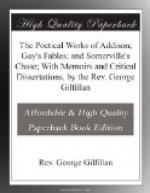This ingenious poet and child-like man was born, in 1688, at Barnstable, in Devonshire. His family, who were of Norman origin, had long possessed the manor of Goldworthy, or Holdworthy, which came into their hands through Gilbert Le Gay. He obtained possession of this estate by intermarrying with the family of Curtoyse, and gave his name, too, to a place called Hampton Gay, in Northamptonshire. The author of the “Fables” was brought up at the Free School of Barnstable—Pope says under one William Rayner, who had been educated at Westminster School, and who was the author of a volume of Latin and English verse, although Dr Johnson and others maintain that his master’s name was Luck. On leaving school, Gay was bound apprentice to a mercer in London—a trade not the most propitious to poetry, and which he did not long continue to prosecute. In 1712, he published his “Rural Sports,” and dedicated it to Pope, who was then rising toward the ascendant, having just published his brilliant tissue of centos, the “Essay on Criticism.” Pope was pleased with the honour, and ever afterwards took a deep interest in Gay. In the same year Gay had been appointed domestic secretary to the Duchess of Monmouth. This lady was Anne Scott, the daughter and heiress of the Duke of Buccleuch, and widow of the well-known and hapless Duke of Monmouth, who had been beheaded in 1685. She plays a prominent part in the “Lay of the Last Minstrel,” and of her a far greater poet than her secretary thus sings:—
“The Duchess mark’d his weary
pace,
His timid mien, and reverend face,
And bade her page the menials tell
That they should tend the old man well:
For she had known adversity,
Though born in such a high degree;
In pride of power, in beauty’s bloom,
Had wept o’er Monmouth’s bloody
tomb.”
Dr Johnson says of her, rather sarcastically, that she was “remarkable for her inflexible perseverance in her demand to be treated as a princess.” One biographer of Gay asserts—but on what authority we know not—that this secretaryship was rewarded with a handsome salary. With her, however, our poet did not long agree. She was scarcely so kind to him as to the “Last Minstrel” who sung to her at Newark. By June 8th, 1714, (see a letter of Arbuthnot’s of that date,) she had “turned Gay off,” having probably been provoked by his indolence of disposition and improvidence of conduct.
Ere this, however, he had been admitted to the intimacy of Pope, and was hired or flattered by him to engage in the famous “Battle of the Wits,” springing from the publication of the “Pastorals” of Ambrose Philips. This agreeable but nearly forgotten writer published some pastorals, which Steele, with his usual rashness and fatal favouritism, commended in the “Guardian” as superior to all productions of the class, (including Pope’s,) except those of Theocritus, Virgil, and Spenser. Pope retorted in a style of inimitable irony, by a letter to the




